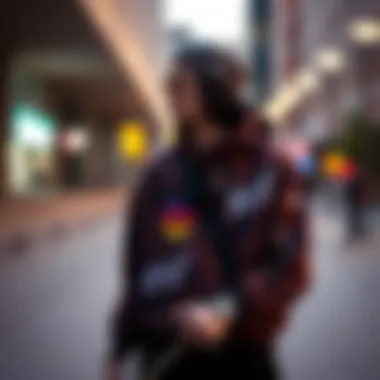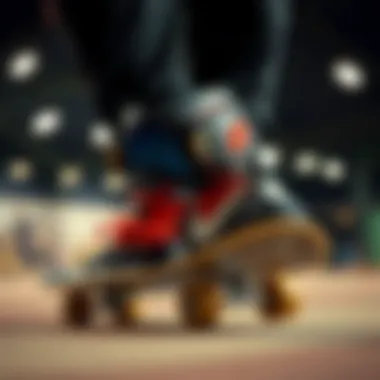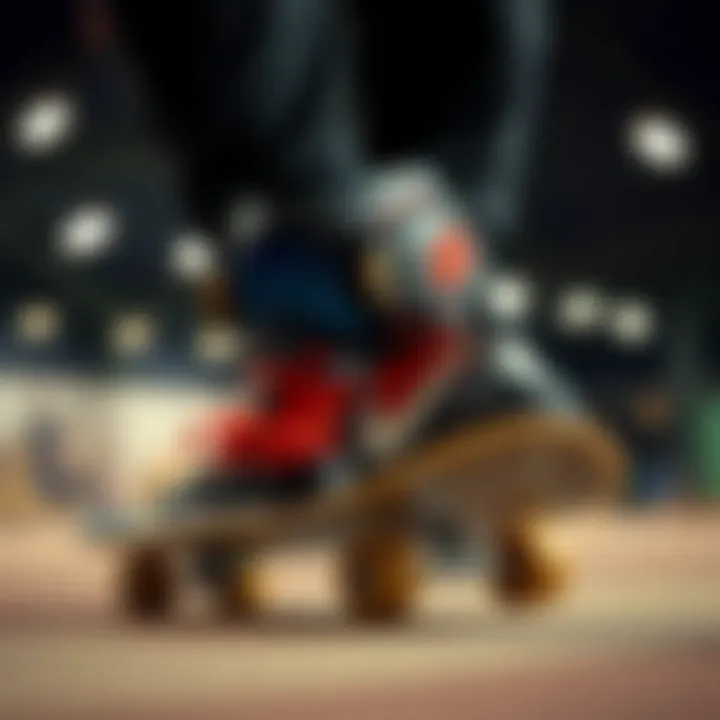Future Official Clothing: Style in Skateboarding


Intro
The world of skateboarding is not just about tricks and flips; it's an intricate tapestry woven from culture, style, and performance. As skateboarding continues to bloom into a global phenomenon, the clothing designed for skaters is evolving too. It is no longer sufficient for garments to simply look good; they must also cater to the functional needs of skaters, aligning with their lifestyle and values.
In this exploration, we delve into how future official clothing is set to reshape the skateboarding context. From aesthetics to performance enhancements, several elements come into play—sustainability, technology, and community narratives are at the core of such evolution. With a keen eye on emerging trends and designs, we will analyze how clothing influences a skater's experience, reflecting the diverse backgrounds of both amateur and seasoned professionals. Let's journey deeper into the intertwining of skateboarding and fashion, a world where form meets function seamlessly.
Historical Context of Skateboarding Apparel
Understanding the historical context of skateboarding apparel is crucial when discussing its evolution and future. This context not only highlights where the scene has come from but also allows us to appreciate the nuances in style and functionality that have developed over the years. The way skaters dress reflects more than just personal taste; it's intertwined with the culture, community, and even politics, shaping identities from its inception to today.
One of the key benefits of delving into the historical roots is recognizing how skateboarding fashion emerged as a rebellious response to mainstream culture. Exploring this helps us grasp the ethos behind the choices skaters make today regarding their gear. The evolution of this apparel serves as a canvas showcasing shifts in society, art, music, and attitudes towards youth culture.
The Roots of Skate Fashion
The inception of skate fashion can be traced back to the early 1970s when surf culture began to influence skateboarders in California. Old-school skaters wore basic clothing suited for functionality, such as plain tee-shirts and baggy shorts, that allowed for freedom of movement. However, as skateboarding gained popularity, apparel began to reflect a unique style distinct from both surfing and mainstream fashion.
Skaters like Tony Hawk and the Z-Boys were not just shredding ramps; they were starting a movement. They turned to brands like Vans and Converse, which produced shoes that complemented their need for grip and durability. The first skate shoes feature a sticky rubber sole and a design that was functional but also spoke to their identity. The era recorded on the edgy prints and colorful graphics served as a declaration proclaiming individuality and community.
Fashion began to shift significantly within this initial framework. Streetwear influences started to emerge, with graphic tees becoming a staple item as skaters looked for ways to express their personalities on and off their boards. This change marked the transformation of skateboarding apparel from mere functionality into a symbol of personal identity and culture.
Evolution Through Decades
As we moved into the 1980s and 90s, skate fashion exploded, hand-in-hand with the sport's growth in visibility. Brands like Thrasher and Element came onto the scene, selling not just clothing but a lifestyle. Graphic-heavy designs and oversized clothing came to symbolize the laid-back, rebellious nature of skateboard culture. The rise of baggy pants and oversized shirts represented freedom both on the board and within societal norms.
Moreover, the 1990s saw the emergence of skateboarding in popular media, with films and shows showcasing not only the sport but also the fashion that accompanied it. Suddenly, kids in suburbs wanted to emulate the skaters they saw on-screen. A wave of consumer demand led to an influx of skate-oriented apparel in mainstream retail locations.
- Pop culture influences: An ongoing relationship with music, especially punk rock and hip-hop, heavily influenced skate fashion. Band tees became ubiquitous; styles from these genres spilled over into skate culture, further reinforcing an image that was outside the norm.
- Technological advancements: With the advent of new materials like synthetic blends and innovations in textile designs, skate apparel also saw a merging between performance and style. The adaptability of fabric innovations came to support skaters' needs for durability, comfort, and style — a foretaste of future trends to come.
In summary, from its humble beginnings rooted in practicality to becoming a worldwide apparel phenomenon, skateboarding clothing has undergone a remarkable evolution. Imagining the future requires an understanding of this rich backdrop, paving the way for a redefined skateboarding aesthetic that values identity, community, and technological advances.
Current Trends in Skateboarding Clothing
The landscape of skateboarding clothing is in a state of flux, driven by an intriguing mix of cultural influences, practical demands, and the ever-evolving tastes of the skating community. As skaters push their boundaries—both on the board and in their style—the current trends in skateboarding clothing have become crucial indicators of where the culture is heading. The fusion of form and function defines what’s currently popular.
Streetwear Influence
Streetwear has, without question, made its mark on skate fashion. Once considered ancillary to the core skateboarding apparel scene, streetwear has found its way into the closets of skaters everywhere. This movement stems from a need to express individual style while remaining true to the roots of skate culture. For instance, brands like Supreme and Off-White have bridged the gap between high fashion and skateboarding. Skaters often find themselves donning oversized tees and hoodies adorned with bold graphics or logos, often functioning both as statement pieces and as a way to create a sense of belonging.
Many observers note that the rise of streetwear has led to a democratization of skate fashion. No longer confined to specific skate brands, skaters now have a plethora of options, allowing for varied personal expression. This allows new enthusiasts to integrate easily into the culture while providing seasoned skaters fresh palette choices.
"The skateboarder’s look has become a document of urban culture, communicating a lifestyle rather than just an activity," says commentator Lex Fonn.
This crossover into streetwear not only influences the aesthetic but also the materials used in production. Skaters are now looking for breathable fabrics that can withstand wear and tear while also being stylish. So, what does this mean for upcoming seasons? An expectation for higher quality and unique collaborative pieces that reflect creativity and adaptability.
Functionality Meets Style
Moving on from sheer aesthetic appeal, functionality has become a non-negotiable aspect of contemporary skate clothing. The evolution of skateboarding techniques demands equally adaptive apparel to match the intensity and environment of the sport. There's a noticeable shift toward fabrics engineered for performance—think moisture-wicking materials combined with durable stitching to endure long sessions at the park.
Pockets have become more specialized, catering to skater needs for zippers and closures that secure essentials. The trend of loose-fitting pants or shorts also reflects a practical approach to comfort, enabling greater mobility without sacrificing style. More brands collaborate with fabric technologists to create anti-chafe seams and stretch capabilities that mold to the wearer's movements. All these innovations enhance the rider’s performance while also catering to their artistic inclinations.
The result is a harmonious blend of practicality and style that resonates deeply within the community. The holistic view of skate clothing now encompasses how it feels on the body as much as how it looks.
In summary, the current trends in skateboard clothing capture the dynamic essence of skate culture. With streetwear influencing skate aesthetics and practicality shaping design choices, skaters are more empowered than ever to forge their unique identities through what they wear.


To remain ahead in this vibrant scene, both brands and skaters alike must prioritize balance between style, comfort, and function, ensuring that the essence of skateboarding continues to be reflected in the clothing worn on and off the board.
The Role of Branding in Skate Fashion
Branding plays a monumental role in shaping skate fashion, acting as the bridge between personal identity and community belonging. In the skateboard scene, where individuality stems from a rich tapestry of history and culture, a brand can represent more than just clothing; it can embody values, aspirations, and a lifestyle. The influence of branding is pervasive, affecting not only consumer choices but also how skaters perceive themselves and their affiliations. In essence, skate fashion isn't merely about what looks good—it's about signaling who you are and where you belong.
Iconic Skate Brands
To appreciate the weight of branding in the skateboarding world, one needs to look no further than the brands that have achieved cult status among skaters. Think of Thrasher, which has transcended its origin as a skateboard magazine to become a symbol of rebellion and authenticity. Wearing a Thrasher shirt isn’t just a fashion choice; it stands as a badge of honor that denotes a certain level of commitment to the sport.
Another pivotal name is Vans. Known for their durable skate shoes, Vans has built a legacy that embraces the unique style of skateboarding while ensuring functionality. The checkerboard pattern has become almost synonymous with skate culture itself. This goes to show that successful brands encapsulate not only quality but also cultural relevance.
Moreover, Supreme has carved out a niche that blends skate culture with high-fashion, creating a sub-culture all its own. Its limited releases and coveted collaborations elevate the discussion of exclusivity, underscoring the relationship between scarcity and desirability in skate fashion.
In the end, it's not just about the clothes themselves. It's about what these brands represent and how they resonate with the core values of the skating community—daring, creative, and always pushing boundaries.
The Impact of Celebrity Endorsements
In recent years, celebrity endorsements have reshaped the landscape of skate fashion, introducing a new layer of complexity in the interplay between skaters and the brands they choose. The appearance of renowned athletes or influencers, such as Tony Hawk or Nyjah Huston, in specific brand campaigns shifts the perception of those brands. Suddenly, they are not just products; they become aspirational entities tied to industry giants who have proven themselves time and again on the board.
When such figures don the gear and proudly display their affiliations, they don't just push merchandise—they convey a narrative of success and a shared passion. Celebrities bring skate fashion into the mainstream, allowing brands to reach wider audiences while also lending a certain legitimacy to the apparel. This can make or break emerging brands as they seek both identity and market presence.
"A brand is no longer what we tell the consumer it is—it is what consumers tell each other it is."
— Scott Cook, co-founder of Intuit
The effects of these endorsements can be double-edged. While they lift brands into new realms of visibility, they also run the risk of alienating core skaters who feel that mainstreaming diminishes authenticity. In many ways, skate fashion operates in a continuous ebb and flow between soul and commercialization, reflecting the vibrant yet often conflicting ideals within skating culture.
Whether it’s the story behind a legendary brand or the allure of an endorsed product, the role of branding remains central to the discussion of skate fashion. Without it, the community would lose much of its unique aesthetic and cultural significance.
Sustainability in Skateboarding Apparel
In recent years, skateboarding culture has started to embrace sustainability within fashion. It’s not just about looking cool on the board anymore. Many skaters and brands are now realizing that the future of skate fashion must align itself with environmental consciousness. As the impacts of fast fashion become clearer, skaters are beginning to demand an apparel industry that respects both the earth and their personal style. Highlighting sustainability in skateboarding apparel is crucial for developing responsible practices that cater to the needs and values of the community.
The importance of this topic extends beyond choosing between earth-friendly materials or traditional textiles. It encompasses a shift in mindset within the skate community. By choosing sustainable options, skaters contribute to a larger movement that fights against pollution and waste while still expressing individuality and style. There is an intrinsic connection between skateboarding ethos and the principles of sustainability — both emphasize freedom, creativity, and a sense of belonging, making them complementary areas for development.
Eco-Friendly Materials
When we talk about eco-friendly materials, we generally mean textiles and fabrics that are produced with minimal environmental impact throughout their lifecycle. For skate apparel, that could include organic cotton, hemp, and recycled polyester.
- Organic Cotton: Unlike conventional cotton, organic cotton is grown without synthetic fertilizers or pesticides. This not only reduces chemical runoff but also promotes biodiversity in farming.
- Hemp: Hemp is a remarkable and underrated material. It grows quickly, needs little water, and enriches the soil as it grows. Hemp fabric is durable and breathable, making it suitable for the rough and tumble of skate life.
- Recycled Polyester: Made from recycled plastic bottles, this material can significantly reduce waste and energy consumption compared to virgin polyester production. Using recycled polyester can also contribute to a more circular economy, keeping materials in use longer.
Integrating such materials doesn't just make the clothing environmentally friendly — it can also enhance comfort and durability. Skaters desire quality gear that can withstand the wear and tear of daily skating, making the choice of sustainable materials a practical one as well.
The Future of Green Manufacturing
The conversation surrounding sustainability inevitably leads to the processes behind clothing production itself. The future of green manufacturing hangs heavily on adopting more eco-sensitive techniques. Many industry leaders are recognizing this shift and are exploring advances in technology that make sustainable practices attainable.
For instance, methods like waterless dyeing technology and low-energy production methods are innovative approaches that reduce the environmental footprint of garment manufacturing. Additionally, utilizing local production networks can minimize transportation emissions while supporting local economies. This growth doesn't just improve sustainability; it fosters community ties within the skate market, encouraging collaboration between local artists and brands.
"The future of skate apparel lies in creating a union where style meets responsibility. It’s about breaking molds and skating towards a greener horizon."
In summary, sustainability in skateboarding apparel is not merely a trend; it’s an essential evolution for the culture. Investing in eco-friendly materials and green manufacturing practices helps create a future that is not only stylish but also conscientious. By embracing sustainability, skaters can proudly wear their values while promoting a culture that maintains respect for both the planet and their passion for skateboarding.
Technological Innovations in Clothing
In the evolving landscape of skateboarding apparel, technological innovations in clothing play an essential role in enhancing both performance and style. These advancements are not just about looking good while shredding the streets; they significantly impact how skaters interact with their environment. High-quality fabrics that breathe while withstanding the rigors of skateboarding ensure comfort and durability, addressing the unique needs of the skateboarding community.


As skate culture continues to grow, prospective skaters and established veterans both expect more from their gear. With cutting-edge materials and innovations, brands can now offer pieces that perform well and cater to the aesthetic preferences of individuals, bridging the gap between functionality and fashion.
Smart Fabrics and Performance
Smart fabrics are pioneering a revolution within skating attire. These textiles, embedded with technology, can adapt to varying conditions, offering something like moisture-wicking properties or temperature regulation. Imagine a shirt that cools you down after an intense session, or pants that stretch just right during those crucial tricks.
The benefits of smart fabrics are numerous:
- Moisture Management: Fabrics that wick away sweat can make a significant difference on those hot summer days. Keeping dry allows skaters to maintain their grip and performance without hampering their movements.
- Enhanced Durability: Many of these fabrics are designed to resist abrasions and tears, which is crucial as skaters often face spills and falls.
- Lightweight Comfort: Innovations in textile development mean that materials can be lighter without sacrificing strength, allowing for greater freedom and ease of movement while skating.
Moreover, these smart textiles can also include functionality like UV protection, which is beneficial since skateboarding often happens outdoors. Overall, the introduction of smart fabrics directly aligns with the skater’s need for high-performance gear that withstands the test of wear and tear, embodying the essence of skate culture itself.
Wearable Technology in Skate Apparel
The integration of wearable technology into skate apparel is yet another exciting frontier. Smart wearables enable skaters to monitor various aspects of their performance in real-time. These can range from basic activity tracking to advanced metrics that analyze style, speed, and even landing angles. With options like Bluetooth-enabled garments that sync with mobile apps, skaters can track their progress, set goals, and even engage with their peers through shared data.
Some notable advancements include:
- Sensors Embedded in Clothing: This technology can help monitor heart rate and calorie burn, allowing skaters to gauge their exertion and ensure they are training effectively.
- GPS Tracking: For those who roam from park to park, wearable technology can offer location tracking, which could be beneficial for both safety and finding the best spots to skate.
- Virtual Reality Integration: In a more future-oriented approach, some brands are exploring ways to integrate wearing technology with VR experiences, so skaters can simulate tricks or analyze their stunts from various angles.
"The best skateboard apparel does more than look good; it enhances your experience and empowers you to push your limits."
As these technologies continue to develop, they will only become more essential components of skateboarding apparel, ensuring that skaters can both express themselves and perform at their peak.
Community Narratives Behind Clothing Choices
The skateboarding community is a tapestry woven from personal stories and collective experiences, where clothing serves as a distinct marker of identity. The narratives around clothing choices are not merely a reflection of style but stem from deeper layers of individual expression. For skaters, every piece of apparel holds significance that goes beyond mere fashion. Here, we’ll explore why these narratives are vital in shaping and redefining skate apparel.
Personal Identity and Self-Expression
In the world of skateboarding, personal identity is often intertwined with clothing choices. For many skaters, the act of selecting what to wear is a form of self-expression, a visual language that communicates who they are and what they represent. This is particularly true in a culture that thrives on non-conformity.
- Individual Stories: Each skater embodies their identity through the colors, patterns, and styles of their attire. Whether it’s the vibrant hues of a designer’s summer drop or the rugged charm of thrifted finds, clothing choices narrate individual journeys. A young woman might sport an oversized vintage tee, hinting at her love for ’90s aesthetics, while a seasoned pro might favor minimalist designs that reflect years of carving out their space in the industry.
- Beyond the Board: Clothing can also signify affiliations with certain brands or communities. For instance, wearing a hoodie from a local skate shop may convey a sense of belonging or loyalty, crafting bonds with fellow skaters even if they’ve never met. Thus, clothing can foster interpersonal connections, demonstrating that identity in the skate world can be both solitary and communal.
“What you wear on a board speaks volumes about who you are off it.”
Cultural Significance of Skate Fashion
Skate fashion transcends aesthetics; it carries cultural weight and social implications. The clothing choices of skaters often reflect broader societal influences, drawing inspiration from music, art, and various subcultures.
- Reflection of a Scene: The skateboarding scene has origins that are deeply rooted in punk, hip-hop, and street art. The borrowed styles reflect the attitudes and struggles prevalent in these communities. In this context, the clothing becomes a canvas where societal narratives—like resistance or unity—are expressed.
- Bridging Generations: Today's younger skaters can draw inspiration from iconic styles of earlier eras while adding their flair, echoing historical cycles of reinvention. This connection to the past not only maintains cultural continuity but invites dialogue between generations of skaters. A 15-year-old might wear baggy cargo pants recalling the early 2000s, while subtly nodding to modern streetwear influences, showcasing how skate fashion evolves.
In a nutshell, narratives underscore the importance of clothing choices in skateboarding, amplifying personal identity and cultural expression. The relationship between skaters and their apparel is a dynamic dialogue, one that speaks volumes about individuality, community, and the intricate ties of culture that define skateboarding today.
As the industry moves forward, the significance of these narratives might grow, telling new stories and forging connections that resonate with newer generations of skaters. For skaters, the old adage rings true: clothing is not just about the threads but the narrative they carry.
Inclusive Fashion in Skateboarding
Inclusive fashion within the skateboarding scene has blossomed into a necessity, resonating with the core values of community and self-expression. With skateboarding deeply rooted in individualism, incorporating inclusivity broadens the horizon for who can participate and enjoy the sport. It ensures that skaters, regardless of gender, body type, or skill level, find clothing that fits both their style and practical needs. The very essence of skateboarding is rebellion against norms and limitations, and fostering an inclusive culture only solidifies this ethos.
Gender-Neutral Options
The move towards gender-neutral clothing is gaining momentum in skate culture. This trend signifies a shift away from traditional gender binaries, allowing everyone to dress in a way that feels authentic to them. Brands are recognizing that skaters come from diverse backgrounds and may not fit into the narrow definitions of male and female clothing. The success of companies like Palace Skateboards and Noah demonstrates that skaters appreciate options that empower personal identity over outdated stereotypes.


- Flexibility in designs: Gender-neutral options provide unisex sizing, allowing for a wider range of fit without the constraints of gender-targeted styles.
- Bridging gaps: Offering a diverse selection means that skaters who identify as non-binary or gender-fluid no longer feel alienated in their choices.
- Market reach: Engaging a broader audience not only increases sales but also cultivates community, connecting skaters from different walks of life.
Inclusive fashion is relevant in skateboarding not just as a trend but as a structural shift towards acceptance and mutual respect. As the skateboarding community continues to grow, it’s essential for brands to offer options that speak to more than just two genders.
Adaptations for All Skill Levels
Another critical element of inclusive fashion is ensuring adaptations in clothing for all skill levels. Skateboarding can be incredibly intimidating for beginners, but the right apparel can make the journey smoother and more accessible. Clothing should enhance performance and facilitate ease of movement, regardless of how comfortable one is on a board.
Considerations for design modifications include:
- Size range: Providing clothes for varying body types helps ensure that no one is left out of the experience. A streetwear line that extends into larger sizes or youth-friendly cuts ensures that kids and adults alike can enjoy participating.
- Performance features: Materials that offer stretch, breathability, and durability can cater to novices who often fall more and endure wear and tear on their clothes. This could be a game-changer in comfort while mastering new tricks.
- Safe adaptations: For those skaters who are differently abled, customizing designs with adaptive features—like adjustable waistbands for easier wear or reinforced seams for durability—can greatly enhance their experiences.
"Inclusive fashion is not merely an add-on but a fundamental part of the identity and community within skateboarding."
These adaptations are vital. They encourage empowerment and enjoyment, creating a skateboard culture where everyone can feel at home regardless of where they start. Ultimately, inclusivity paves the way for a richer tapestry of experiences and perspectives within skateboarding, enhancing the sport's diversity.
The Future Demands on Skateboarding Apparel
The landscape of skateboarding apparel is shifting beneath our feet. With more skaters embracing individual expression while also watching out for the environment, the demands on future clothing styles have become multifaceted. It’s not all about looking cool; there are deeper implications for how clothing serves the community and the activity itself. In this section, we will explore the nuanced layers of the current expectations for skateboarding apparel, considering everything from market trends to the desires of the skaters who are constantly pushing boundaries.
Evolving Market Expectations
Skateboarding has often been viewed through a narrow lens, primarily as a niche subculture. However, as more brands join the fray, understanding skateboarding’s market has morphed into a necessity. Today's consumers expect more than just functional clothing. They want a blend of style, sustainability, and storytelling in the garments they choose.
To adapt to these evolving expectations, skateboard apparel brands must keep innovation at the forefront. Factors influencing market trends include:
- Sustainability: As awareness around environmental issues heightens, consumers lean toward eco-friendly materials. Brands that utilize organic cotton or recycled fabrics can tap into this conscientious mindset.
- Innovation: Intelligent designs, such as moisture-wicking fabrics and responsive materials, ensure that skaters can perform at their best.
- Inclusivity: Skaters come from all walks of life, and brands should reflect this diverse demographic in their offerings, resulting in expanded size ranges and gender-neutral clothing.
"The clothing a skater wears is like a second skin; it should empower, not restrict."
By responding to these demands, brands foster loyalty among their customer base and create a community that feels understood. Expect minimalistic designs, vibrant graphics, and functional cuts to dominate the collections of tomorrow.
Anticipating Next-Gen Skaters
The skaters of today differ greatly from those of yesterday. The next generation is not just riding boards; they’re simultaneously curating their online presence, blending physical and digital identities. As they step into the scene, apparel brands need to anticipate both their preferences and their challenges to truly keep pace with future developments.
This next-gen cohort often:
- Embraces Technology: Wearable tech or clothing that engages with social media can enhance dialogue between skaters. Imagine a jacket that records your sessions or pants that track your movements!
- Values Individuality: More than mere fashion, skateboarding attire is now a reflection of personal stories and experiences. Products that cater to individual design choices will resonate deeply.
- Connects with Culture: The overlap of skateboarding with other cultural movements—like art, music, or fashion—opens several avenues for collaborations that create richer narratives.
As brands dig deep into understanding what drives these skaters, they will need to strike a balance between performance-enhancing properties and eye-catching aesthetics. The future will not just demand clothing that endures the rigors of skating but also garments that tell the story of each skater’s identity.
By addressing these elements, skateboarding apparel can lead the charge into a new era, weaving in the fabric of performance, community, and style seamlessly. To stay ahead of the curve, brands must constantly engage with their audience, listening to their insights and adapting as the skateboarding culture continues to evolve.
End: Shaping the Future of Official Clothing
As we look towards the horizon of skateboarding apparel, it is increasingly clear that the future demands a thoughtful integration of various elements to shape official clothing. The skateboard community, vibrant and ever-evolving, calls for apparel that not only highlights style but also enhances performance and resonates with personal identity.
The intersection of functionality and aesthetics stands at the forefront of this evolution. Every piece of clothing must serve a dual purpose. For example, a t-shirt must be flexible enough to allow for high mobility yet stylish enough to be worn during everyday life. This flexibility in design helps connect the skater's lifestyle to their sport. As consumers become more discerning, they prioritize not just how clothing looks, but how it feels and performs.
Sustainability is another cornerstone of future clothing design in skating. The environmental impact of material choices is under scrutiny, prompting brands to consider eco-friendly fabrics and manufacturing processes. Being socially responsible goes hand in hand with forward-thinking style. Brands that successfully marry these aspects will likely find a loyal following, not only from skaters but from a broader audience keen on sustainability.
Technological advancements present exciting avenues for innovation. Smart fabrics and functional features like moisture-wicking or temperature regulation will keep skaters comfortable, which in turn influences their performance. Similarly, wearable technology embedded in clothing can propel this integration further, bringing a new level of personal expression and utility to skateboarding apparel.
The narratives that surround fashion in the skateboarding community are rich and full of meaning. Each garment tells a story—often tied to individual experiences and collective culture. As the community strives for inclusivity, designs that consider a broader demographic, including diverse body types and gender-neutral options, are not just appreciated but necessary.
In shaping the future of skate clothing, various market dynamics must also be considered. As the skateboarding culture becomes mainstream, the demand for official clothing that reflects authentic skate values while appealing to wider audiences becomes paramount. It's a balancing act between staying true to roots and embracing the inevitable evolution that comes with popularity.
"The right gear doesn’t just help you skate; it reflects who you are."
By embracing these principles, the future of official clothing in skateboarding is poised to not only meet the demands of the sport but also to enrich the identity of its practitioners.















